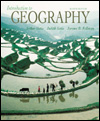 |  Introduction to Geography, 8/e Arthur Getis,
San Diego State University
Judith Getis
Jerome D. Fellmann,
University of Illinois, Urbana-Champaign
Geography of Spatial Behavior
Objectives:After reading and studying this chapter you should be able to:
1.
Explain environmental perception, relating it to spatial cognition.
|
 |  |  | 2.
Explain the logic people use to justify living in high hazard area.
|
 |  |  | 3.
Identify the factors that influence the accuracy of mental maps.
|
 |  |  | 4.
Enumerate the factors, which influence the shape and content of human activity space.
|
 |  |  | 5.
Describe the factors that affect spatial interaction.
|
 |  |  | 6.
Classify various phenomena subject to diffusion into one of the major categories of spatial diffusion.
|
 |  |  | 7.
Know what is meant by distance decay and critical distance.
|
 |  |  | 8.
Identify the important "push" and "pull" factors.
|
 |  |  | 9.
Explain the role of place utility in inducing or inhibiting decision-making.
|
 |  |  | 10.
Identify and draw on a world map the major recent international migration streams.
|
 |  |  | 11.
Analyze any kind of human spatial behavior employing the concepts discussed in this chapter.
|
|



 2002 McGraw-Hill Higher Education
2002 McGraw-Hill Higher Education